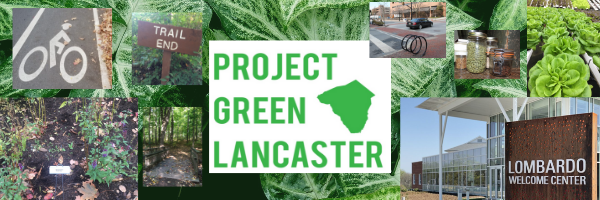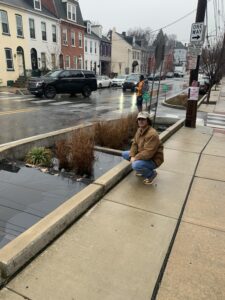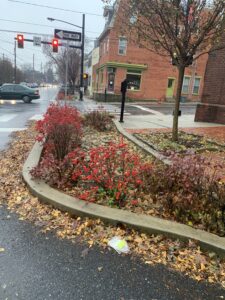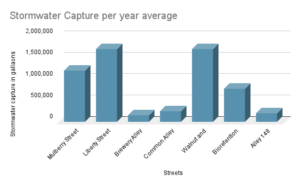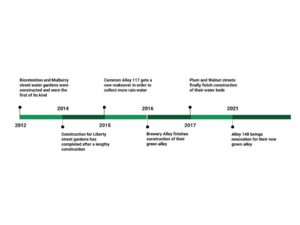by Theo Vela
For over 17 years Lancaster City has undergone many renovations to help create a greener and more eco friendly environment around the city.
I recently had the chance to research and get a first hand look on how these specific green boxes located around the city help benefit the cities environment.
There are 6 green boxes located around Lancaster city and each one serves a specific purpose.
Street and Alleys that have been turned green
- Mulberry Street – This green box was constructed in late 2014. This green box is an extension of the street which includes many types of vegetation. This green box is also a rain garden where stormwater can be collected so the streets do not become flooded with rainwater. Along the corner of Mulberry and West James Street is where this box is located. This green box also promotes better traffic flow as Mulberry will be turned back into a 2 way street. Not only will this increase traffic patterns but it will also boast bike lanes and permeable paving.
Photo By Kacey Emmell
- Liberty Street- This location opened up in early 2014 and is one of the leading water capture zones in the city. Its green infrastructure combines to capture 1.3 millions of gallons of water every year to stop flash flooding.
- Brewery Alley- Most city homes in Lancaster border an alley, all common alleys are shared property with the home owners. Over the last 8 years work to improve alley greenery has been steadily moving along. Brewery Alley has been improved the most with an addition of a storm drain. This alley alone collects 150,000 gallons of water per year on average.
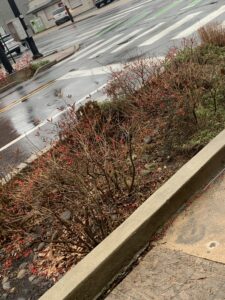
Photo by Theo Vela
- Common Alley 117- This alley runs parallel with W Orange street between Mary and Pine streets in the Northwest corner of the City. Like Brewster Alley this alley is publicly owned by the homeowners on the Alley. It is the first alley to go to construction with support from the Department of Environmental Protection Growing Greener Fund. The city has worked with the property owners via meetings to incorporate suggested improvements while educating the homeowners on how these improvements will benefit the homeowners. The improvement to the alley will ultimately increase stormwater draining to reduce localized flooding around the area. This alley will collect more than 250,000 gallons of water per year.
- Intersection of walnut and Plum Street- This project integrates green infrastructure with road alignment to help increase positive traffic patterns and pedestrian safety. This project is a series of vegetated curb extensions to capture stormwater and calm traffic patterns. This green project will capture 1.7 millions of gallons of water annually. The Walnut and Plum storm drainage project won the best Urban BMP in the bay areas. This award recognizes the best urban stormwater management practices that have been installed in the Chesapeake watershed.
- Alley 148- The last location that is getting a green makeover is Alley 148. With over 28 miles of alleys in Lancaster city, there were some that needed more repairs than others. Alley 148 was selected to be upgraded and renovated to become a green alley. Meaning that this alley will be repaved to improve water catching and to help improve traffic patterns around the allies. These repairs and renovations alone will help collect over 199,000 gallons of water per year on average. This green zone will be a crucial part of stormwater draining and reduce the chance of flooding.
Photo By Theo Vela
- Bioretention(rain gardens)- As you drive around Lancaster City you may find extended street corners or curb extensions with vegetation in them. Bioretention areas often called rain gardens are shallow surface depressions planted with specially selected, native vegetation to treat and capture runoff and are sometimes underlain by sand or gravel storage. Bioretention is a method of managing stormwater by pooling water within a planting area and then allowing the water to infiltrate the garden. These bioretention gardens collect around 770,000 gallons of water per year on average.

Photo By Theo Vela
Other Green Lancaster projects
To go along with the Bioretention gardens and water beds. Lancaster CIty has instituted new “Green Sidewalks”. Just like the bioretention gardens these sidewalks were created to improve street quality and help stormwater flow. Some green infrastructure of these new sidewalks include, curb extensions, sidewalk planters, tree trenches and porous pavements. Most people had their sidewalk renovated to help with the incorporation of ADA requirements. A number of these small curbside rain gardens have been popping up all over the city. These curbside gardens serve to both help capture more rainwater and help improve traffic patterns by slowing down traffic and making it safer for pedestrians to walk.
To again go along with the helping of making Lancaster green, the city introduced green parking lots as well. The green parking lots were introduced back in 2013 to help regulate stormwater flow and collection of stormwater. The underbelly of these parking lots is sediment, meaning it is easier for water to seep through and collect underneath. In addition to collecting stormwater, these new parking lots were repaved, trees were planted, lighting was improved in these parking areas, and these repavings allowed for better parking placement. These parking lots are located in 3 spots across Lancaster, Community mennonite church, the southeast parking lot located on Plum street, and Franklin and Marshall College.
The Leaders of the Projects
Fritz Schroeder is Director of Urban Greening with the Lancaster County Conservancy. He has been working with the county for over 15 years. Schroeder is responsible for implementing both the residential and institutional aspects of the urban greening initiative in Lancaster City. A native of Lancaster county himself, he has been involved with the green project for over 10 years. Schroeder explains that his Green missions are to build strong and healthy communities through the environmental process. He grabs people from all three sectors (nonprofit, for-profit, and government) to help make these green projects a reality and hope for new environmental initiatives.
Phil Wegner is another leader in these green projects as he is the President of Lancaster Conservancy. Lancaster Conservancy is an accredited nonprofit land trust that protects and restores natural lands for future generations. Wegner the leader of this group leads his team members to help grow the green projects to multitudes so people will support them. He states that Lancaster County is one of those special and unique places where we still have farmland and we still have wild places. The Conservancy works directly with the city of Lancaster to help provide these projects with funding and resources to help make Lancaster City green.
References:
“Streets and Alleys Green Project .” Save It!, http://www.saveitlancaster.com/local-projects/steets-alleys/.
Courtesy of LNP, Lancaster. “Ex-Isaac’s Chief and EMU Alumnus Phil Wenger Excited to Lead Lancaster County Conservancy.” EMU News, 30 Nov. 2015, https://emu.edu/now/news/2015/ex-isaacs-chief-and-emu-alumnus-phil-wenger-excited-to-lead-lancaster-county-conservancy/.
“Save It Lancaster .” Save It!, http://www.saveitlancaster.com/.
Fritz Schroeder – Director of Urban Greening – Linkedin. https://www.linkedin.com/in/fritzschroeder.
